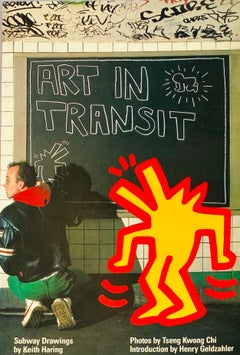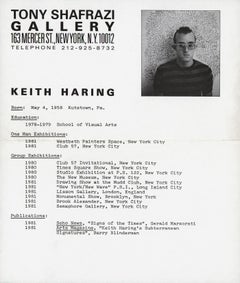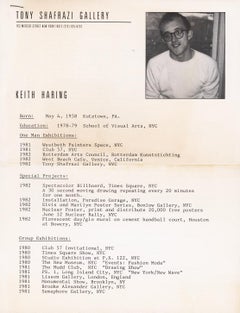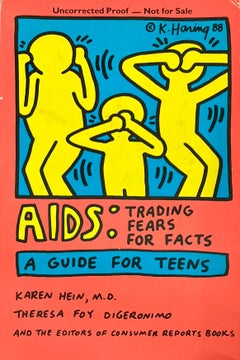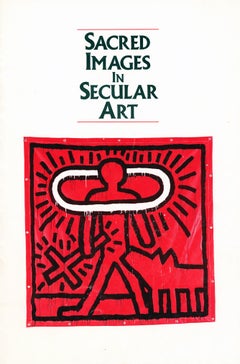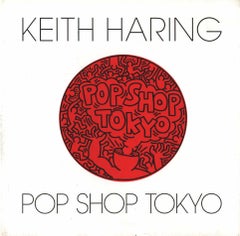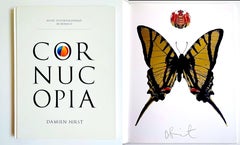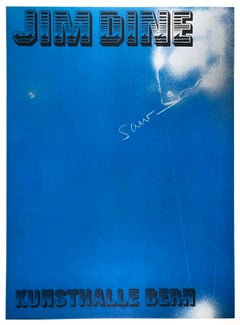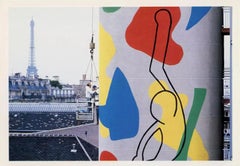(after) Keith Haring Photography
American, 1958-1990
Keith Allen Haring was an American artist whose pop art emerged from the New York City graffiti subculture of the 1980s.to
1
9
Overall Width
to
Overall Height
to
9
9
9
7
1
1
4
4
4
3
2
2
2
2
2
1
1
1
1
1
1
1
7
5
1
81
9,417
2,685
1,362
1,180
9
Artist: (after) Keith Haring
Keith Haring Art in Transit 1984 (Keith Haring Tseng Kwong Chi book)
By (after) Keith Haring
Located in NEW YORK, NY
Keith Haring 1984:
Keith Haring, Art in Transit: Subway Drawings with Photos by Tseng Kwong Chi:
This highly collectible & well preserved 1984 Keith Haring monograph examines them m...
Category
1980s Pop Art (after) Keith Haring Photography
Materials
Paper
Keith Haring Tony Shafrazi gallery 1982 (Keith Haring resume)
By (after) Keith Haring
Located in NEW YORK, NY
Keith Haring Tony Shafrazi Gallery New York circa 1982:
Rare original Keith Haring artist biography sheet produced by Tony Shafrazi ...
Category
1980s Pop Art (after) Keith Haring Photography
Materials
Offset, Paper
Keith Haring Tony Shafrazi gallery resume
By (after) Keith Haring
Located in NEW YORK, NY
Keith Haring Tony Shafrazi Gallery New York circa 1983:
Rare original Keith Haring artist biography sheet & timeline produced by Ton...
Category
1980s Pop Art (after) Keith Haring Photography
Materials
Offset, Paper
Keith Haring 1980's/1990s ephemera collection (Keith Haring pop shop)
By (after) Keith Haring
Located in NEW YORK, NY
1980s/1990s Keith Haring ephemera collection:
A collection of 20+ Keith Haring ephemera pieces ranging mostly from 1982 to circa mid-1990s. Highlights include a 1980's Haring design...
Category
1980s Pop Art (after) Keith Haring Photography
Materials
Offset, Paper
Keith Haring Sacred Images in Secular Art (Whitney Museum Catalogue 1986)
By (after) Keith Haring
Located in NEW YORK, NY
Sacred Images In Secular Art catalog by Whitney Museum of American Art, 1986:
Catalog of an exhibition held at the Museum, May 1-July 13, 1986 featuring Keith Haring cover imagery. Twelve American artists including Brice Marden, Jean-Michel Basquiat, Robert Mapplethorpe & Keith Haring were part of this exhibition featuring the use of sacred images in secular art. The catalogue essay briefly describes each of the works in the show.
9 x 6 inches; 18 pages; offset printed; 1986.
Good overall vintage condition with the exception of some handwriting on verso.
Unsigned form a scarce edition of unknown.
Keith Haring rose to prominence in 1980s New York within the East Village art scene alongside Jean-Michel Basquiat, Kenny Scharf, and Jenny Holzer. He bridged the gap between the art world and the street, graffiting city subways and sidewalks before committing to a studio practice. Haring united the appeal of cartoons with the raw energy of Art Brut artists such as Jean DuBuffet as he developed a distinct pop-graffiti aesthetic that comprised energetic, boldly outlined figures against solid or patterned backdrops. His major themes included exploitation, subjugation, drug abuse, and the threat of nuclear holocaust; Haring boldly engaged with social issues, especially after receiving an AIDS diagnosis in 1987. Today, his work sells for seven figures at auction and has been the subject of solo shows at the Brooklyn Museum, the San Francisco Museum of Modern Art, and the Albertina Museum in Vienna, among other institutions.
Related Categories
Keith Haring religous. Keith Haring catalog...
Category
1980s Pop Art (after) Keith Haring Photography
Materials
Paper
Keith Haring Pop Shop Tokyo 1992 (monograph)
By (after) Keith Haring
Located in NEW YORK, NY
Keith Haring Pop Shop Tokyo book 1992:
Rare vintage Keith haring monograph which well documents the history of Keith Haring's Tokyo Pop Shop; features many photographs by Haring's longtime friend and collaborator Tseng Kwong Chi.
Softcover; 68 pages; 1st edition 1st printing, 1992.
9.75 x 9.5 inches.
Minor surface & age related wear to front & back cover; in otherwise good overall vintage condition.
Text in German & English.
Published by Galerie Kunst Parterre / George Mulder Fine Arts.
Unsigned from an edition of 1500. Rare.
Keith Haring Pop Shop:
In 1986, Keith Haring opened the Pop Shop at 292 Lafayette Street, New York. The following year, Haring collaborated with Japanese film producer Kaz Kuzui, and his American wife, film director Fran Rubel Kuzui on a Tokyo venue, in the Aoyama neighborhood.
The shop was made out of two shipping containers welded together to form one large room. While the shop was conceived very much in the image of its New York counterpart, many of the products were created by Haring to mirror Japan’s cultural traditions. Haring did extensive design work in Tokyo; fans and kimonos were manufactured in Kyoto, and rice bowl templates were painted and then produced in Nagoya. With speed and virtuosity, Haring began painting the interior of the shop on January 27, 1988 and finished the next day. The paint was still tacky on January 29 when he oversaw the installation of the displays in time for a press preview that evening. On Saturday, January 30, Pop Shop Tokyo opened to the public. However, sales were disappointing, and Haring noted “there are just too many Haring fakes available all over Tokyo and, this time, they’re really well done.” The shop closed in the summer of 1988. (source: New York Historical Society.
Related Categories
Keith Haring pop shop. Keith haring Japan. Keith Haring catalog...
Category
1980s Pop Art (after) Keith Haring Photography
Materials
Paper
Keith Haring Stedelijk Museum 1986 (Keith Haring 1986 exhibition catalog)
By (after) Keith Haring
Located in NEW YORK, NY
Keith Haring Stedelijk Museum, Amsterdam, Netherlands, March 15th – 12th May, 1986:
The rare, much sought-after catalog to Keith Haring'...
Category
1980s Pop Art (after) Keith Haring Photography
Materials
Paper
Keith Haring 1987-1996: set of 30 announcements (Keith Haring pop shop)
By (after) Keith Haring
Located in NEW YORK, NY
A collection of 30 Keith Haring announcement cards ranging mostly from 1987 to the mid 1990s. Highlights include Keith Haring’s 1990 memorial exhibition at Tony Shafrazi gallery; 198...
Category
1980s Pop Art (after) Keith Haring Photography
Materials
Offset, Lithograph
Keith Haring at Tony Shafrazi Gallery (set of 3 vintage Haring collectibles)
By (after) Keith Haring
Located in NEW YORK, NY
Vintage Keith Haring exhibition cards 1988-1990:
A highly collectible set of three vintage original Keith Haring exhibition cards (1987-1990):
"Keith Haring: Sculpture & Painting" ...
Category
1980s Pop Art (after) Keith Haring Photography
Materials
Offset
Related Items
Cornucopia (limited edition hardback monograph hand signed by Damien Hirst)
By Damien Hirst
Located in New York, NY
Damien Hirst
Cornucopia, 2010
Limited edition hardback monograph (hand signed by Damien Hirst)
Hand signed in ink by Damien Hirst on the first front end page
12 1/2 × 9 3/4 × 3/4 inches
This limited edition illustrated hardback monograph, with no dust jacket, exactly as issued, was published on the occasion of the artist's show at Musee Oceanographique de Monaco in April 2010, 'Cornucopia' celebrates Hirst's paintings and sculptures from 1994-2009." This book was gifted by Damien Hirst to a member of an American Rock & Roll band that Hirst befriended.
Stated Limited Edition of 2000 (unnumbered)
About the book:
Publisher: Musée Océanographique de Monaco, 2010
Text: English / French. 160 pgs with color illustrations
Limited Edition: 2000 (the regular edition is not signed; this was exceptionally hand signed by Hirst)
About Damien Hirst:
People are afraid of change, so you create a kind of belief for them through repetition. It’s like breathing. I’ve always been drawn to series and pairs. A unique thing is quite a frightening object.
—Damien Hirst
Since emerging onto the international art scene in the late 1980s, Damien Hirst has created installations, sculptures, paintings, and drawings that examine the complex relationships between art and beauty, religion and science, and life and death. From serialized paintings of multicolored spots to animal specimens...
Category
2010s Pop Art (after) Keith Haring Photography
Materials
Paper, Ink, Mixed Media, Lithograph, Offset
$1,250
H 12.5 in W 9.75 in D 0.75 in
Vintage Jim Dine tool poster Kunsthalle Bern (Saw) neon blue 1970s retro font
By Jim Dine
Located in New York, NY
Original exhibition poster printed on the occasion of Jim Dine's 1971 exhibition at Kunsthalle Bern, featuring Saw, 1971. Against a sea of electric blue, Dine has written “saw” in lo...
Category
1970s Pop Art (after) Keith Haring Photography
Materials
Paper, Offset
Roy IV.
By Roy Lichtenstein
Located in Slovak Republic, SK
A Hahnemuehle Fine Art Print, attributed to Roy Lichtenstein. Editioned 25.
Category
Mid-20th Century Pop Art (after) Keith Haring Photography
Materials
Photographic Paper, Color, Archival Pigment, Digital Pigment
Roy II.
By Roy Lichtenstein
Located in Slovak Republic, SK
A Hahnemuehle Fine Art Print, attributed to Roy Lichtenstein. Editioned of 25.
Category
Mid-20th Century Pop Art (after) Keith Haring Photography
Materials
Photographic Paper, Color, Digital, Archival Pigment
TAKASHI MURAKAMI: Who's afraid of red, yellow... Superflat, Japanese Pop Art
By Takashi Murakami
Located in Madrid, Madrid
Takashi Murakami - WHO'S AFRAID OF RED, YELLOW, BLUE AND DEATH
Date of creation: 2011
Medium: Offset lithograph with silver and silkscreen with spot UV varnishing
Edition: 300
Size:...
Category
2010s Pop Art (after) Keith Haring Photography
Materials
Paper, Varnish, Offset, Screen
$4,689
H 30.32 in W 23.63 in
HOMAGE TO FRANCIS BACON: STUDY FOR HEAD OF GEORGE DYER Gold Superflat Japan Pop
By Takashi Murakami
Located in Madrid, Madrid
Takashi Murakami
HOMAGE TO FRANCIS BACON: STUDY FOR HEAD OF GEORGE DYER
Date of creation: 2016
Medium: Offset lithograph with cold foil stamp on paper
Edition: 300
Size: 50 x 50 cm
...
Category
2010s Pop Art (after) Keith Haring Photography
Materials
Paper, Lithograph, Offset
$3,345
H 19.69 in W 19.69 in
Looking at Art With Alex Katz, hardback monograph hand signed by Alex Katz
By Alex Katz
Located in New York, NY
Alex Katz
Looking at Art With Alex Katz (hand signed by Alex Katz), 2018
Hardback monograph with dust jacket (hand signed in black pen on the title page)
hand signed by Alex Katz in ...
Category
2010s Pop Art (after) Keith Haring Photography
Materials
Paper, Ink, Mixed Media, Lithograph, Offset, Board
$595
H 8.5 in W 6 in D 1 in
“The Winter Ball” 1988
Located in Austin, TX
Poster Size: 23.5 x 16.5 in.
Vintage Gold Leaf Frame Size: 23.5 x 16.5 in.
Signed and inscribed in gold marker, bottom right
A poster for "The Winter Ball 1988" in Houston, Texas, p...
Category
1980s Pop Art (after) Keith Haring Photography
Materials
Paper, Lithograph, Offset
Some Los Angeles Apartments - Artist Book published in a limited edition of 3000
By Ed Ruscha
Located in New York, NY
Ed Ruscha
Some Los Angeles Apartments, 1970
Softback monograph with stiff wraps
Second Edition Limited Edition of 3000 (the first edition in 1968 was 700)
7 × 5 1/2 inches
Accompanie...
Category
1970s Pop Art (after) Keith Haring Photography
Materials
Paper, Mixed Media, Lithograph, Offset
Andy Warhol in his New York studio, 1976 (Palm Springs Art Museum) Signed Framed
By Michael Childers
Located in New York, NY
MICHAEL CHILDERS
Andy Warhol in his New York studio, 1976
Photographic print
Printed in 2007
Signed boldly on the front in black felt tip pen by photographer Michael Childers
Frame included: in the original frame as donated by the photographer to the Palm Springs Art Museum
This is one of a series of portraits of Andy Warhol by Michael Childers, founding photographer of Warhol's Interview and After Dark magazines, taken in his New York studio and Paris from 1976-1980. This work is signed on the front and framed. It was acquired from the Palm Springs Art Museum, where it was donated by the artist.
The verso of the frame bears the works title, original year in felt tip marker, and the artist's studio stamp with copyright of 2007 (year printed)
Another example of this work was exhibited at the Palm Springs Art Museum and a different example is part of the Michael Childers collection at the Las Vegas Art Museum
Measurements:
Artwork (visible): 7 x 9 7/8 inches
Frame: 12 x 15 x .4 inches
Michael Childers Biography:
Since the 1960s, Michael Childers has been photographing famous people...
Category
1970s Pop Art (after) Keith Haring Photography
Materials
Photographic Paper
$7,500
H 12 in W 15 in D 0.4 in
Jean-Michel Basquiat 1984 poster, hand signed and numbered by Richard Corman
By Richard Corman
Located in New York, NY
Richard Corman
Jean-Michel Basquiat 1984 (Red), 2020
Offset lithograph poster on color archival pigment paper
Signed and numbered 2/100 by Richard Corman in silver sharpie on the fro...
Category
2010s Pop Art (after) Keith Haring Photography
Materials
Archival Paper, Lithograph, Offset
Keith Haring 1 - NYC, 1985 hand signed, numbered twice; hand painted wood frame
By Richard Corman
Located in New York, NY
Richard Corman
Keith Haring 1 - NYC, 1985 (hand signed twice), 2022
Photographic print on Hahnemühle Photo Rag Ultrasmooth paper mounted on Dibond aluminum board. (Hand signed and nu...
Category
2010s Pop Art (after) Keith Haring Photography
Materials
Metal
$15,000
H 41.5 in W 38.25 in D 2 in
Previously Available Items
Keith Haring Tseng Kwong Chi Art In Transit book 1984
By (after) Keith Haring
Located in NEW YORK, NY
Keith Haring 1984:
Keith Haring, Art in Transit: Subway Drawings with Photos by Tseng Kwong Chi:
This highly collectible & well preserved 1984 Keith Haring monograph examines them m...
Category
1980s Pop Art (after) Keith Haring Photography
Materials
Paper
Keith Haring High Museum of Art 1988 (announcement)
By (after) Keith Haring
Located in NEW YORK, NY
Keith Haring 1988:
This rare 1988 announcement card from the High Museum of Art announces a lecture & series of workshops by Keith Haring. The front ...
Category
1980s Pop Art (after) Keith Haring Photography
Materials
Offset, Lithograph
Keith Haring Pop Shop poster (vintage Keith Haring posters)
By (after) Keith Haring
Located in NEW YORK, NY
Keith Haring Pop Shop poster /folded mail order catalogue & rare mailing envelope, circa 1989.
Imagery: Tseng Kwong Chi’s, ‘Keith Haring in the Pop Shop’ (c.1983).
Offset lithograph; double-sided.
16x22 inches.
Good to very good overall vintage condition with fold-lines as originally issued. Includes original Keith Haring Pop Shop envelope & mail order form.
Unsigned from an edition of unknown. Published by Keith Haring Pop Shop New York circa 1986-1989.
Imprinted along left side: Keith Haring in the Pop Shop, 292 Lafayette Street, New York City, New York 10012.
Keith Haring Pop Shop:
In 1986, New York artist Keith Haring opened the Pop Shop in downtown Manhattan. Haring saw the Pop Shop as an extension of his work, a fun boutique where his art could be accessible to everyone. For nearly twenty years, the shop continued to be a downtown attraction with floor-to-ceiling murals...
Category
1980s Pop Art (after) Keith Haring Photography
Materials
Lithograph, Offset
Keith Haring Pop Shop poster (vintage Keith Haring posters)
By (after) Keith Haring
Located in NEW YORK, NY
Keith Haring Pop Shop poster /folded mail order catalogue & rare mailing envelope, circa 1989.
Imagery: Tseng Kwong Chi’s, ‘Keith Haring...
Category
1980s Pop Art (after) Keith Haring Photography
Materials
Lithograph, Offset
Keith Haring Tseng Kwong Chi Art In Transit book 1984
By (after) Keith Haring
Located in NEW YORK, NY
Keith Haring, Art in Transit: Subway Drawings with Photos by Tseng Kwong Chi:
This highly collectible & well preserved 1984 Keith Haring monograph examines them much historic & semi...
Category
1980s Pop Art (after) Keith Haring Photography
Materials
Paper
Keith Haring Stedelijk Museum catalog Amsterdam (vintage Keith Haring)
By (after) Keith Haring
Located in NEW YORK, NY
Keith Haring at the Stedelijk Museum, Amsterdam, Netherlands, March 15th – 12th May, 1986:
A rare, sought-after catalog to Keith Haring's first major...
Category
1980s Pop Art (after) Keith Haring Photography
Materials
Paper
1984 Keith Haring Tseng Kwong Chi Art In Transit announcement
By (after) Keith Haring
Located in NEW YORK, NY
Tseng Kwong Chi, Keith Haring ‘Art In Transit’ Semaphore East Gallery, New York, NY 1984:
Vintage original 1984 exhibition announcement ca...
Category
1980s Pop Art (after) Keith Haring Photography
Materials
Offset
Keith Haring Pop Shop poster (vintage Keith Haring posters)
By (after) Keith Haring
Located in NEW YORK, NY
Keith Haring Pop Shop poster /folded mail order catalogue circa 1989.
Imagery: Tseng Kwong Chi’s, ‘Keith Haring in the Pop Shop’ (c.198...
Category
1980s Pop Art (after) Keith Haring Photography
Materials
Lithograph, Offset
Keith Haring Into 84 (Haring Bill T. Jones Shafrazi announcement card 1983)
By (after) Keith Haring
Located in NEW YORK, NY
Keith Haring into 84/Painted Man:
Original 1983 Keith Haring announcement card for Haring’s well-documented exhibition, Keith Haring 'Into 84' at Tony Shafrazi Gallery, New York, 19...
Category
1980s Pop Art (after) Keith Haring Photography
Materials
Offset
Keith Haring Into 84 (Haring Bill T. Jones Shafrazi announcement card 1983)
By (after) Keith Haring
Located in NEW YORK, NY
Keith Haring into 84/Painted Man:
Original 1983 Keith Haring announcement card for Haring’s well-documented exhibition, Keith Haring 'Into 84' at Tony Shafrazi Gallery, New York, 19...
Category
1980s Contemporary (after) Keith Haring Photography
Materials
Offset
Keith Haring Bill T. Jones Into 84 (set of 3 Tony Shafrazi announcements)
By (after) Keith Haring
Located in NEW YORK, NY
Keith Haring Into 84:
A set of 3 announcement cards for Keith Haring’s well-documented exhibition, "Into 84" at the Tony Shafrazi Gallery, NY, 1983. For this series Haring borrowed ...
Category
1980s Pop Art (after) Keith Haring Photography
Materials
Offset
Keith Haring 1984 Paul Maenz catalog (vintage Keith Haring)
By (after) Keith Haring
Located in NEW YORK, NY
Original Keith Haring at Paul Maenz Catalog, 1984. First edition:
Rare vintage catalog produced during the artist’s lifetime. This well received 1984 Cologne show marked Haring’s 1st solo exhibition in Germany. Beautifully illustrated and in very nice condition. Quite scarce.
Approx 8 x 11 inches
12 pages. Printed on colored stock, the catalogue beautifully features of Haring, and his works.
Minor surface bending on reverse upper right. Otherwise very good overall condition.
Related Categories
Keith Haring prints. Keith Haring posters. Keith Haring Into 84. Keith Haring Bill T. Jones. Keith Haring body paint. Vintage Keith Haring 1984.
Category
1980s Pop Art (after) Keith Haring Photography
Materials
Offset
(after) Keith Haring photography for sale on 1stDibs.
Find a wide variety of authentic (after) Keith Haring photography available for sale on 1stDibs. If you’re browsing the collection of photography to introduce a pop of color in a neutral corner of your living room or bedroom, you can find work that includes elements of blue and other colors. You can also browse by medium to find art by (after) Keith Haring in offset print, lithograph, paper and more. Much of the original work by this artist or collective was created during the 1980s and is mostly associated with the Pop Art style. Not every interior allows for large (after) Keith Haring photography, so small editions measuring 6 inches across are available. (after) Keith Haring photography prices can differ depending upon medium, time period and other attributes. On 1stDibs, the price for these items starts at $250 and tops out at $1,450, while the average work can sell for $408.
Questions About (after) Keith Haring Photography
- Where is Keith Haring from?1 Answer1stDibs ExpertMarch 22, 2022Keith Haring is originally from Kutztown, Pennsylvania, although he was born in the nearby city of Reading, Pennsylvania, on May 4, 1958. In 1978, Haring moved to New York City. He continued to live there until he died on February 16, 1990. Find a selection of Keith Haring art on 1stDibs.
- Who is Keith Haring?1 Answer1stDibs ExpertMarch 22, 2022Keith Haring was a modern American artist and activist. He began as a street artist creating graffiti-inspired works throughout New York City’s subway system and would later produce public murals in cities all over the world. Haring’s paintings, prints and murals address the universal themes of death, love and sex, as well as contemporary issues he experienced personally, like the crack-cocaine and AIDS epidemics. In 1986, Haring opened a Pop Shop in Manhattan’s Soho neighborhood to sell merchandise bearing his bold, cartoon-inspired designs. On 1stDibs, find a variety of Keith Haring art.
- 1stDibs ExpertMarch 22, 2022The Keith Haring Foundation is a philanthropic organization founded by the artist Keith Haring in 1989. Its mission is to provide funding for nonprofit organizations who offer services and programs for children or conduct research or educational initiatives related to AIDS.
- What was Keith Haring known for?1 Answer1stDibs ExpertAugust 8, 2024Keith Haring was known for his work as an artist. He began experimenting with his bold, graphic lines and cartoon-inspired figures on the walls of New York City subway stations in the early 1980s. He called these underground places his “laboratory” to develop a radical new aesthetic based on the ideology of creating truly democratic public art. Haring used paintings, prints and murals to address the universal themes of death, love and sex, as well as contemporary issues he experienced personally, like the crack-cocaine and AIDS epidemics. These works derive much of their impact from the powerful contrast between these serious subjects and the joyful, vibrant pictographic language he used to express them, full of dancing figures, babies, barking dogs, hearts and rhythmic lines, as well as references to pop culture. To make his art even more accessible, in 1986, Haring opened the Pop Shop in Soho. In a foreshadowing of today’s intermingling of art and fashion, the shop sold merchandise and novelty items featuring his imagery. Find a collection of Keith Haring art on 1stDibs.
- When was Keith Haring born?1 Answer1stDibs ExpertMarch 22, 2022Keith Haring was born on May 4, 1958, in Reading, Pennsylvania. After growing up in Kutztown, Pennsylvania, and briefly attending art school in Pittsburgh, Pennsylvania, he moved to New York City, where he made a name for himself creating street art on the subway system. Haring gained an even larger audience in the years that followed, producing public murals that were often commissioned and making art that was frequently informed by political and cultural issues. On 1stDibs, find a selection of Keith Haring art.
- 1stDibs ExpertFebruary 1, 2024Some facts about Keith Haring include that he began his career by creating street art in New York subway stations, which he referred to as his "laboratory." In 1986, Haring opened the Pop Shop in Manhattan’s Soho neighborhood and began selling merchandise and novelty items featuring imagery by himself and contemporaries like Kenny Scharf and Jean-Michel Basquiat. Also, the world's largest jigsaw puzzle features Haring's artwork and consists of 32,000 pieces. After his death, his estate formed the Keith Haring Foundation to raise awareness about AIDS and fund research into the autoimmune disease. On 1stDibs, explore a wide range of Keith Haring art.
- Where did Keith Haring live?1 Answer1stDibs ExpertMarch 22, 2022For most of his life, Keith Haring lived in New York City and died there on February 16, 1990. He grew up in Kutztown, Pennsylvania, and briefly attended an art school in Pittsburgh, Pennsylvania. After he arrived in New York in 1978, he turned the city into a gallery space, creating murals in public areas like subway stations. On 1stDibs, shop a collection of Keith Haring art.
- What inspired Keith Haring?1 Answer1stDibs ExpertMarch 22, 2022Keith Haring drew most of his inspiration from graffiti artists and got his start painting subway stations and other locations around New York City. In addition, artists such as Pierre Alechinsky, William Burroughs, Jean Dubuffet, Brion Gysin and Robert Henri influenced his work. On 1stDibs, shop a collection of Keith Haring art.
- Why is Keith Haring important?1 Answer1stDibs ExpertMarch 22, 2022Keith Haring is important primarily because his innovative work, which began as street art on the New York City subway, became widely known during the 1980s and influenced other artists working at the time. Haring was also an activist — his late-career prints and murals addressed contemporary issues he experienced personally, like the crack-cocaine and AIDS epidemics. Haring helped elevate graffiti art and was one of the first artists to begin placing his designs on merchandise sold to the general public through his Pop Shop in New York City. Shop a collection of Keith Haring art on 1stDibs.
- How do I pronounce Keith Haring?1 Answer1stDibs ExpertMarch 22, 2022To pronounce Keith Haring, say "Keeth HEH-ring." Keith Haring was born on May 4, 1958, in Reading, Pennsylvania, and grew up in nearby Kutztown, Pennsylvania. You'll find a range of Keith Haring art on 1stDibs.
- What is Keith Haring famous for?1 Answer1stDibs ExpertMarch 22, 2022Keith Haring is famous for producing bold cartoon-style art. You may see his work printed on everything from home décor to coffee mugs to fashion accessories. He gained notoriety for street art in his early days as an artist. Later, Haring’s revered paintings, prints and murals would address the universal themes of death, love and sex, as well as contemporary issues he experienced personally, like the crack-cocaine and AIDS epidemics. On 1stDibs, find a collection of Keith Haring art.
- Where did Keith Haring work?1 Answer1stDibs ExpertMarch 22, 2022In his early days as an artist, Keith Haring worked primarily in New York City, where he created murals on walls and unused advertising boards along Manhattan’s subway system. Once his work gained popularity, he traveled to produce work in Australia, Europe and elsewhere. You'll find a collection of Keith Haring art on 1stDibs.
- 1stDibs ExpertMarch 25, 2024Keith Haring's art was about a variety of subjects. His paintings, prints and murals addressed themes of death, love and sex, as well as contemporary issues, like drug use and the AIDS epidemic. His work derives much of its impact from the powerful contrast between these serious subjects and the joyful, vibrant pictographic language he used to express them. Haring’s enduring work is full of dancing figures, babies, barking dogs, hearts and rhythmic lines, as well as references to pop culture. On 1stDibs, explore a collection of Keith Haring art.
- 1stDibs ExpertApril 16, 2024Keith Haring used a variety of materials. Over the course of his career, he produced works in markers, chalk, felt-tip pens, ink and acrylic paints. For his murals, he often preferred spray paint. Interestingly, the artist rarely made sketches for even his largest works, preferring to improvise during the creation process. Find a wide range of Keith Haring art on 1stDibs.
- 1stDibs ExpertMarch 22, 2022Keith Haring became famous largely through people viewing the street art he created in subway stations and other locations in New York City. Throughout the 1980s, he was commissioned to produce art in dozens of cities all over the world and showed his works in solo and group exhibitions. A 1982 show at the Tony Shafrazi Gallery in Soho, New York City, earned rave reviews and greatly contributed to his fame. You'll find a selection of Keith Haring art on 1stDibs.
- 1stDibs ExpertMarch 22, 2022The type of art that Keith Haring primarily did was drawing. He is most often associated with the Pop art movement. Initially, Haring was inspired by graffiti artists and began experimenting with his bold, graphic lines and cartoon-inspired figures on the walls of New York City subway stations in the early 1980s. After gaining recognition for his innovative street art, Haring was commissioned to create murals in cities all over the world. Shop a range of Keith Haring art on 1stDibs.
- 1stDibs ExpertJune 6, 2024The style of Keith Haring's art is Pop art. When creating his paintings and murals, he drew inspiration from cartoons and used this playful approach to provide commentary on the issues of his time, such as the crack and AIDS epidemics, and the universal themes of death, love and sex. Since he got his start experimenting with his bold, graphic lines and figures on the walls of New York City subway stations, many people have also referred to him as a street artist. Shop a range of Keith Haring art on 1stDibs.
- 1stDibs ExpertMarch 22, 2022Keith Haring began to paint and experiment with art as a child. He first began to produce public art in 1981. His early works were chalk or paint applied to unused advertising panels found in New York City subway stations. Find a collection of Keith Haring art on 1stDibs.
- 1stDibs ExpertMarch 22, 2022You can see Keith Haring art at many museums in North America, Europe and Asia. In New York City, some of his pieces hang in the Museum of Modern Art and the Museum of the City of New York. Some of his murals remain in the city, as well. A map of all of the existing murals is available on the Keith Haring Foundation's website. Shop a collection of Keith Haring art on 1stDibs.
- 1stDibs ExpertMarch 22, 2022Keith Haring went to school briefly at the Ivy School of Art in Pittsburgh, Pennsylvania. In 1978, he moved to New York City, where he attended the School of Visual Arts. Other famous alumni from the school include Sarah Sze, James Jean and Joe Sinnott. Find a selection of Keith Haring art on 1stDibs.
Recently Viewed
View AllMore (after) Keith Haring Art
(after) Keith Haring Prints and Multiples
(after) Keith Haring Sculptures
(after) Keith Haring Mixed Media
(after) Keith Haring Figurative Prints
(after) Keith Haring Figurative Sculptures
(after) Keith Haring Animal Prints
(after) Keith Haring Abstract Prints
(after) Keith Haring Nude Prints
(after) Keith Haring Abstract Sculptures
